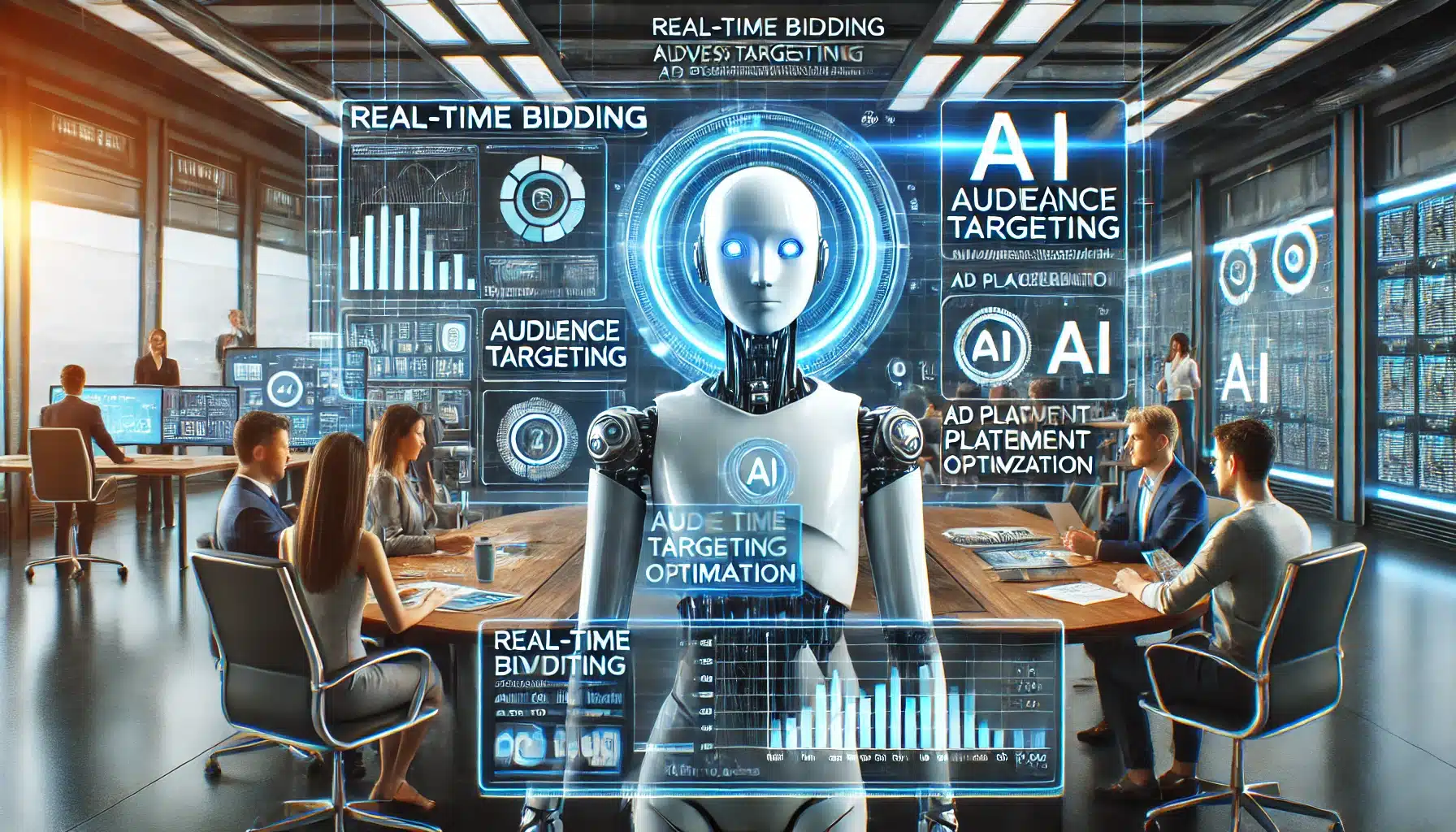Introduction
In the ever-evolving digital marketing landscape, programmatic advertising has emerged as a game-changer. It leverages technology to automate the buying and selling of ad space, ensuring precision and efficiency. With the integration of AI, programmatic advertising has reached new heights, offering unparalleled capabilities in real-time bidding, audience targeting, and ad placement optimization. This article delves into the transformative role of AI in programmatic advertising and media buying, highlighting its benefits, use cases, and best practices.
Understanding Programmatic Advertising
What is Programmatic Advertising?
Programmatic advertising refers to the automated process of buying and selling ad space using technology. It replaces traditional methods that involve manual negotiations and offers a more efficient and data-driven approach to advertising.
Real-Time Bidding (RTB)
One of the core components of programmatic advertising is Real-Time Bidding (RTB). RTB allows advertisers to bid for ad space in real-time, ensuring that ads are displayed to the right audience at the right time. This dynamic process occurs in milliseconds, optimizing ad placements based on various data points.
The Evolution of Programmatic Advertising
Programmatic advertising has evolved significantly since its inception. Initially focused on display ads, it now encompasses various ad formats, including video, mobile, and social media ads. The integration of AI has further revolutionized the landscape, introducing advanced capabilities that enhance efficiency and effectiveness.
The Role of AI in Programmatic Advertising
AI-Powered Audience Targeting
AI algorithms analyze vast amounts of data to identify and target specific audience segments. By understanding user behavior, preferences, and demographics, AI ensures that ads are delivered to the most relevant audience, maximizing engagement and conversion rates.
Behavioral Analysis
AI tools can track and analyze user behavior across different platforms. This includes browsing history, search queries, social media interactions, and more. By understanding these behaviors, AI can create detailed audience profiles and predict future actions.
Predictive Analytics
Predictive analytics uses historical data to forecast future trends. In programmatic advertising, AI leverages predictive analytics to anticipate which audiences are most likely to engage with specific ads. This ensures that ad budgets are spent efficiently, targeting high-potential users.
Ad Placement Optimization
AI optimizes ad placements by analyzing various factors, including user context, device type, and location. This ensures that ads are displayed in the most effective positions, enhancing visibility and engagement.
Contextual Targeting
Contextual targeting involves placing ads in relevant contexts. AI analyzes the content of web pages to determine the best ad placements. For instance, an ad for sports equipment might be placed on a sports news website, increasing the likelihood of user engagement.
Dynamic Creative Optimization (DCO)
DCO involves creating multiple versions of an ad and dynamically serving the most relevant version to each user. AI analyzes user data to determine which ad variant is likely to perform best, ensuring personalized and impactful ad experiences.
Real-Time Bidding (RTB) Enhancements
AI enhances RTB by making data-driven decisions in real-time. It evaluates multiple data points, including user behavior, ad performance, and market trends, to determine the optimal bid for each ad impression.
Bid Shading
Bid shading is an AI-driven strategy that helps advertisers avoid overpaying for ad impressions. By analyzing historical bid data, AI predicts the optimal bid price, ensuring cost-effective ad placements without sacrificing quality.
Fraud Detection
Ad fraud is a significant concern in programmatic advertising. AI-powered tools can detect and prevent fraudulent activities by analyzing patterns and identifying suspicious behaviors. This ensures that ad budgets are not wasted on fake impressions or clicks.
Benefits of AI in Programmatic Advertising
Increased Efficiency
AI automates various aspects of programmatic advertising, reducing the need for manual intervention. This increases efficiency, allowing marketers to focus on strategy and creativity.
Enhanced Precision
AI’s ability to analyze vast amounts of data ensures precise targeting and ad placement. This enhances the effectiveness of campaigns, driving higher engagement and conversion rates.
Cost Savings
By optimizing bids and preventing ad fraud, AI helps advertisers maximize their budgets. This ensures that every dollar spent contributes to achieving marketing objectives.
Improved ROI
The combination of efficiency, precision, and cost savings leads to improved return on investment (ROI). AI-driven programmatic advertising ensures that campaigns deliver the desired results, contributing to overall business success.
Implementing AI in Programmatic Advertising
Choosing the Right AI Tools
Several AI-powered platforms can assist brands in programmatic advertising. Tools like Google Display & Video 360, The Trade Desk, and Adobe Advertising Cloud offer comprehensive features for audience targeting, ad placement optimization, and real-time bidding.
Integrating AI with Human Expertise
While AI can handle many tasks, human expertise is still crucial. Marketing teams should work alongside AI tools to interpret data, make strategic decisions, and maintain personal relationships with clients and partners.
Best Practices for AI-Powered Programmatic Advertising
Define Clear Objectives
Before leveraging AI, brands should define their programmatic advertising objectives. Whether it’s brand awareness, lead generation, or product sales, clear goals will guide the AI’s analysis and recommendations.
Regularly Update Data
Ensure that AI tools are fed with the latest data. Market trends and user behaviors can change rapidly, and keeping the data current is essential for accurate predictions.
Monitor and Adjust Campaigns
Use AI to monitor campaign performance and make real-time adjustments. AI can provide insights into what’s working and what’s not, allowing for quick pivots and optimizations.
Case Studies: Success Stories of AI-Powered Programmatic Advertising
Case Study 1: Brand A
Brand A, a leading e-commerce retailer, used AI-powered programmatic advertising to launch a new product line. By leveraging AI, they achieved a 40% increase in click-through rates and a 25% reduction in cost per acquisition.
The Challenge
Brand A needed to launch a new product line in a highly competitive market. Traditional advertising methods were not yielding the desired results.
The Solution
Using an AI-powered programmatic advertising platform, Brand A optimized audience targeting and ad placements. The AI analyzed user data to deliver personalized ads to high-potential customers.
The Results
The campaign led to a significant increase in click-through rates and a reduction in cost per acquisition. The use of AI allowed Brand A to efficiently reach their target audience and achieve their marketing goals.
Case Study 2: Brand B
Brand B, a global travel agency, utilized AI to optimize their programmatic advertising efforts. AI helped them achieve a 50% increase in conversions and a 30% reduction in ad spend.
The Challenge
Brand B faced the challenge of reaching a diverse audience with varying travel preferences. Traditional advertising methods were not effective in targeting the right customers.
The Solution
AI tools helped Brand B analyze user data and predict travel preferences. The AI optimized ad placements and bidding strategies to ensure that ads were delivered to the most relevant audience.
The Results
The campaign resulted in a significant increase in conversions and a reduction in ad spend. AI-powered programmatic advertising allowed Brand B to efficiently target their audience and achieve their marketing objectives.
The Future of AI in Programmatic Advertising
The Rise of Predictive Analytics
As AI continues to evolve, predictive analytics will play a more significant role in programmatic advertising. AI tools will not only track current performance but also predict future trends, helping brands stay ahead of the competition.
Advantages of Predictive Analytics
Predictive analytics provide brands with foresight, allowing them to anticipate and prepare for potential challenges. This proactive approach enhances campaign performance and strategic planning.
Potential Challenges
While predictive analytics offer many advantages, they also come with challenges. Ensuring the accuracy of predictions and interpreting complex data require advanced skills and expertise.
Increased Personalization
AI’s ability to analyze vast amounts of data will lead to more personalized advertising experiences. Brands will be able to create highly targeted content that resonates deeply with specific audience segments.
Hyper-Targeted Campaigns
AI can segment audiences with incredible precision, allowing brands to tailor their messaging to individual preferences and behaviors. This level of personalization enhances engagement and effectiveness.
Real-Time Adaptation
AI can adapt campaigns in real-time based on audience responses. If certain content is performing well, AI can adjust the strategy to amplify successful elements and mitigate underperforming aspects.
Ethical Considerations
With great power comes great responsibility. The use of AI in programmatic advertising raises ethical questions around data privacy and transparency. Brands must ensure they use AI responsibly and maintain consumer trust.
Data Privacy
Brands must be transparent about how they collect and use data. Ensuring compliance with regulations like GDPR is essential to maintain consumer trust and avoid legal repercussions.
Transparency
Transparency in AI-driven programmatic advertising is crucial. Brands should clearly communicate how AI is used in their advertising strategies and ensure that relationships with stakeholders are authentic and transparent.
Q&A Section
Q1: What is programmatic advertising?
A1: Programmatic advertising refers to the automated process of buying and selling ad space using technology. It involves real-time bidding (RTB) to ensure that ads are delivered to the right audience at the right time, optimizing ad placements based on various data points.
Q2: How does AI enhance audience targeting in programmatic advertising?
A2: AI enhances audience targeting by analyzing vast amounts of data to identify specific audience segments. It uses behavioral analysis and predictive analytics to understand user behavior, preferences, and demographics, ensuring ads are delivered to the most relevant audience.
Q3: What is real-time bidding (RTB), and how does AI improve it?
A3: Real-time bidding (RTB) is a process where ad impressions are bought and sold in real-time through automated auctions. AI improves RTB by making data-driven decisions instantly, evaluating multiple data points to determine the optimal bid for each ad impression.
Q4: How does AI optimize ad placements?
A4: AI optimizes ad placements by analyzing factors such as user context, device type, and location. It uses contextual targeting to place ads in relevant contexts and Dynamic Creative Optimization (DCO) to serve the most relevant ad variant to each user.
Q5: What are the benefits of using AI in programmatic advertising?
A5: The benefits of using AI in programmatic advertising include increased efficiency, enhanced precision, cost savings, and improved ROI. AI automates various aspects of advertising, ensuring precise targeting and optimal ad placements, leading to higher engagement and conversions.
Q6: Can AI help in detecting ad fraud?
A6: Yes, AI can help detect and prevent ad fraud by analyzing patterns and identifying suspicious behaviors. This ensures that ad budgets are not wasted on fake impressions or clicks, maintaining the integrity of ad campaigns.
Q7: What are predictive analytics, and how do they benefit programmatic advertising?
A7: Predictive analytics use historical data to forecast future trends. In programmatic advertising, AI leverages predictive analytics to anticipate which audiences are most likely to engage with specific ads, optimizing ad spend and enhancing campaign effectiveness.
Q8: How can brands ensure ethical use of AI in programmatic advertising?
A8: Brands can ensure ethical use of AI by being transparent about data collection and usage, complying with regulations like GDPR, and maintaining authentic relationships with stakeholders. Ethical practices help maintain consumer trust and avoid legal repercussions.
Conclusion
AI-powered programmatic advertising is transforming how brands connect with their audiences. By automating the processes of audience targeting, ad placement, and real-time bidding, AI offers unparalleled efficiency, precision, and cost-effectiveness. Brands that embrace this technology are better positioned to create impactful, data-driven advertising campaigns that resonate with their target audiences. As AI continues to evolve, it promises a future where programmatic advertising becomes even more personalized, predictive, and ethically sound, ensuring brands can navigate the digital landscape with confidence and success.


